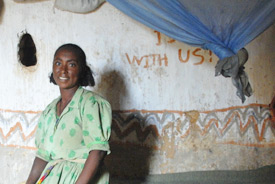 The number of people who die from malaria in Ethiopia has been halved in just three years through the distribution of nearly 20 million insecticide-treated bed nets and widespread use of antimalaria drugs. The dramatic fall in deaths from a disease that kills one in four people was made possible with money from the Global Fund To Fight AIDS, Tuberculosis and Malaria, and a small army of health workers.
The number of people who die from malaria in Ethiopia has been halved in just three years through the distribution of nearly 20 million insecticide-treated bed nets and widespread use of antimalaria drugs. The dramatic fall in deaths from a disease that kills one in four people was made possible with money from the Global Fund To Fight AIDS, Tuberculosis and Malaria, and a small army of health workers.
In 2005, only two percent of households owned an insecticide-treated net and almost half the population had no access to any health care services at all. A plan to get nets out to farming families was floundering, partly because of the sheer number of nets required and partly because of the challenge of distributing them to remote areas.
Ethiopia’s minister of health led a rapid assessment and galvanized the country into a proactive response to malaria. An arrangement was made with The Global Fund to speed up the flow of funds: money allocated for three years was released for spending in just one.
In the scaled-up program, more bed nets were distributed than had previously been planned – 20 million insecticide treated nets to protect the most vulnerable, particularly women and children for whom malaria is more dangerous due to their bodies’ inability to fight the parasite.
The idea was simple: broaden the outreach by training two high school graduates per village to act as health advisers. Now, thirty thousand young women have been mobilized to transfer health skills to the entire community, thanks to The Global Fund which paid for top-up training, disease test kits and drugs.
(READ the full story at The Global Fund)




















There’s no need for flashy high-tech solutions like genetically modified mosquitoes. We just need more goodwill and willingness to go with the tools we already have!